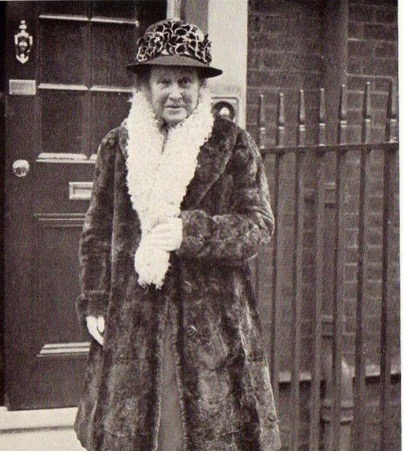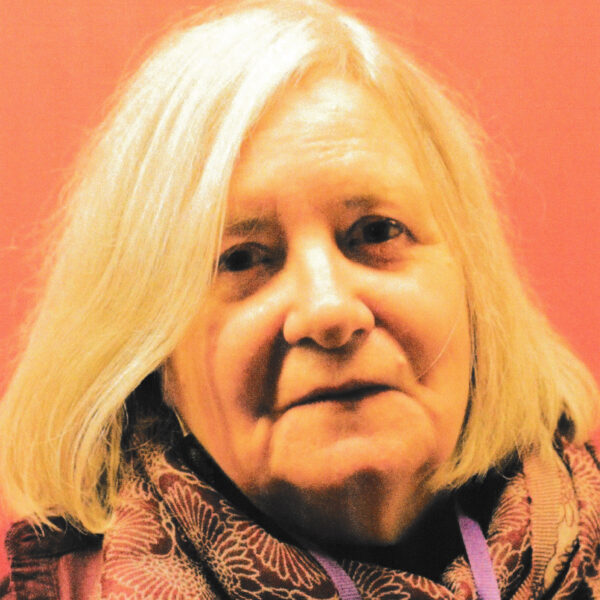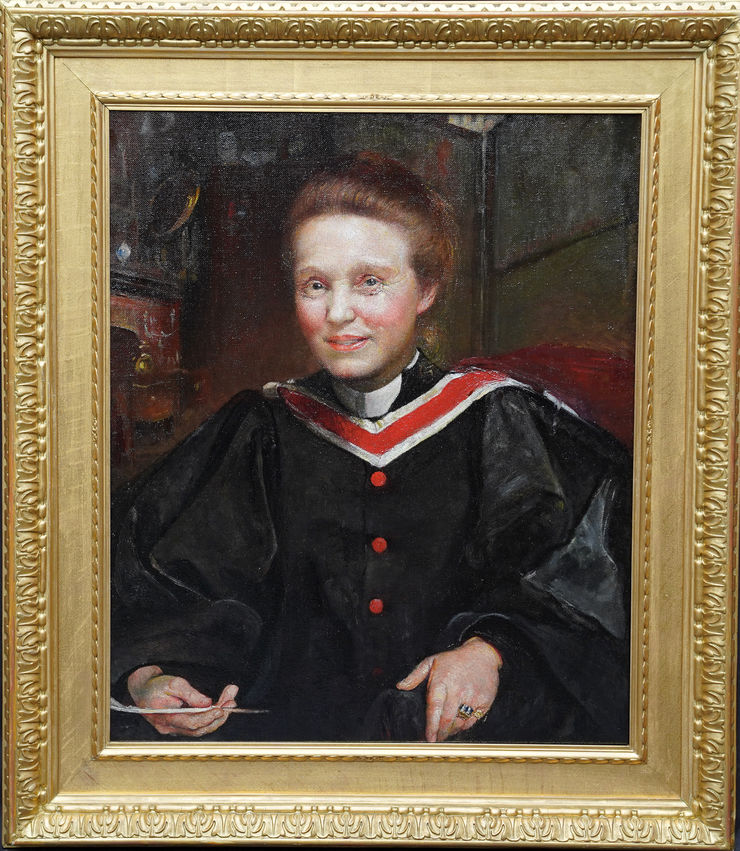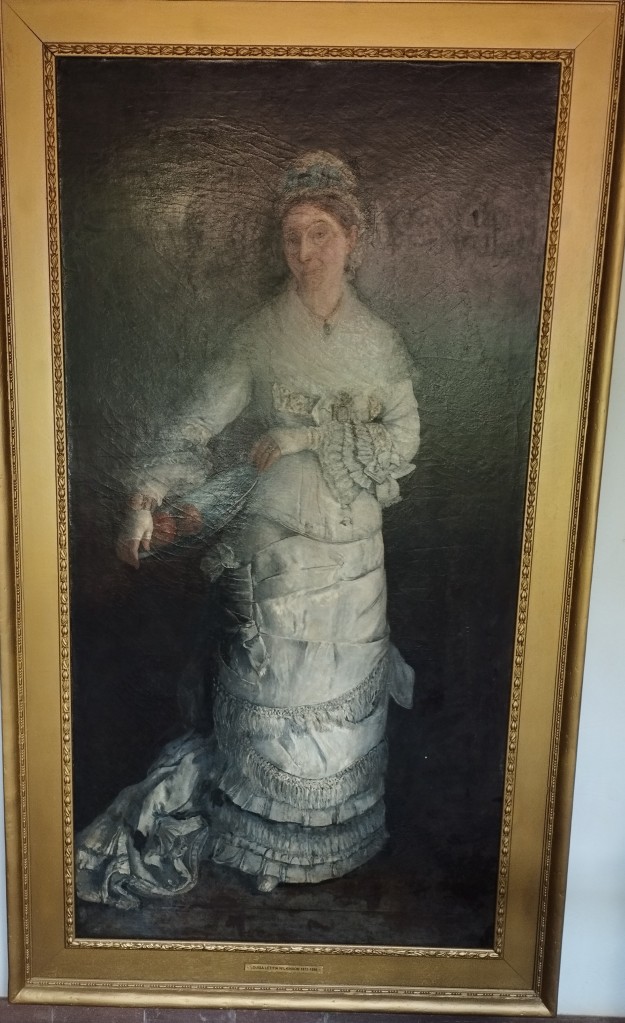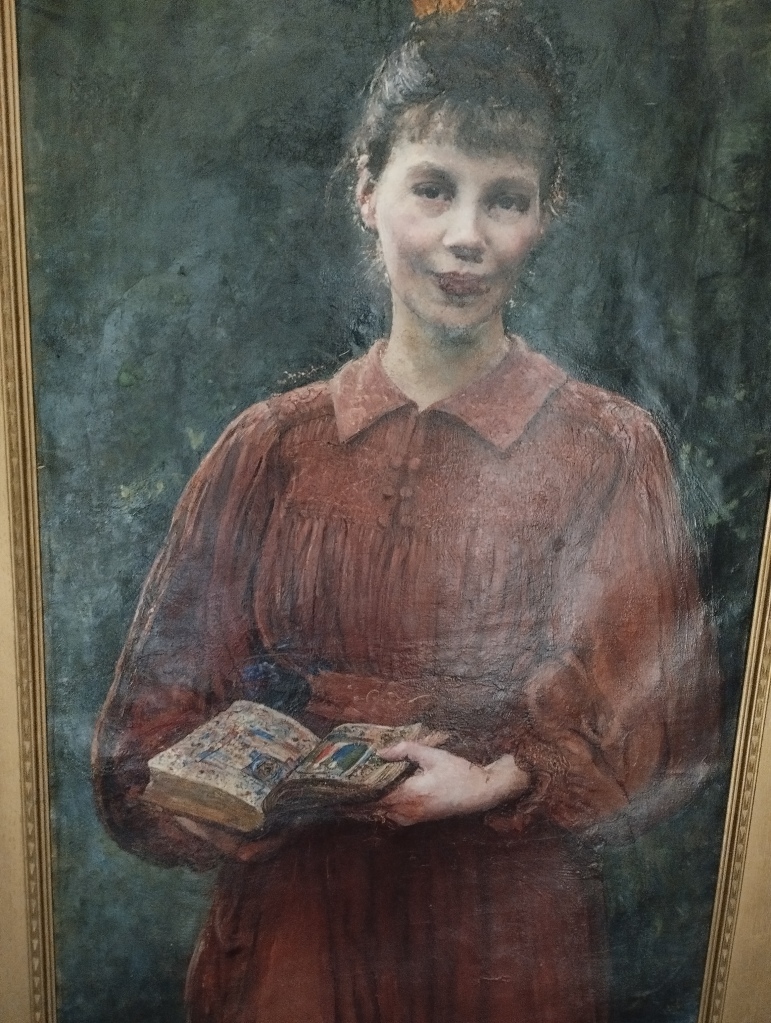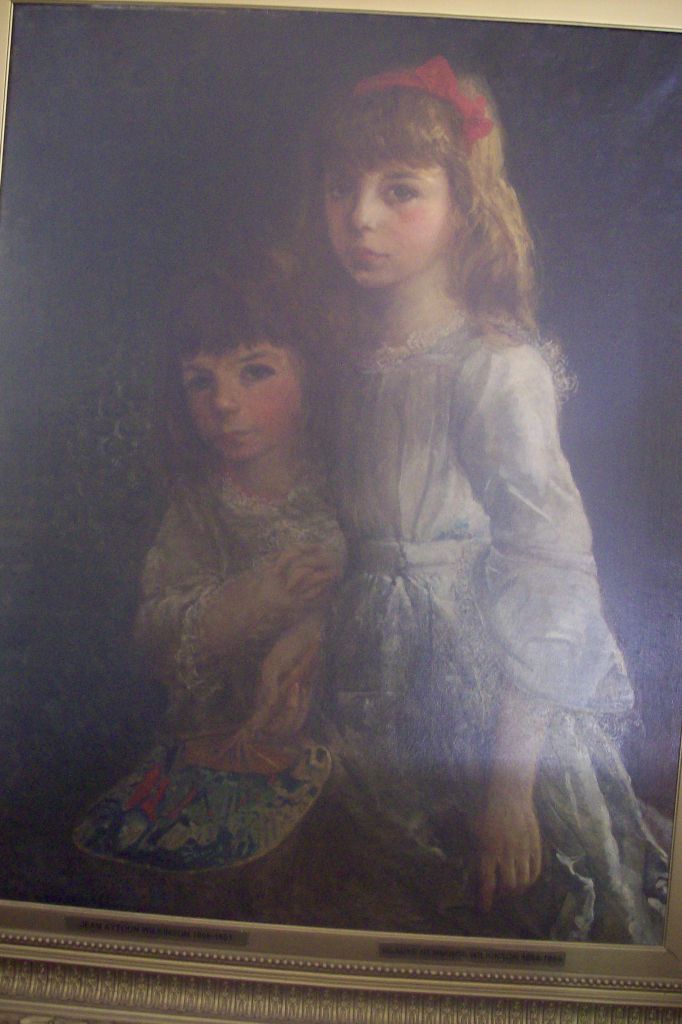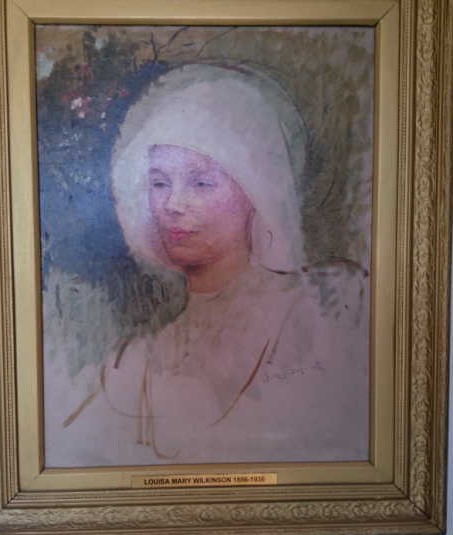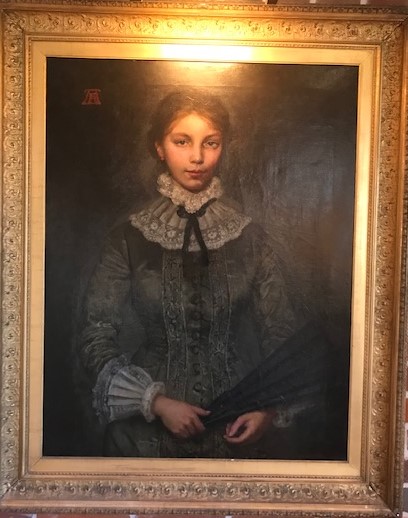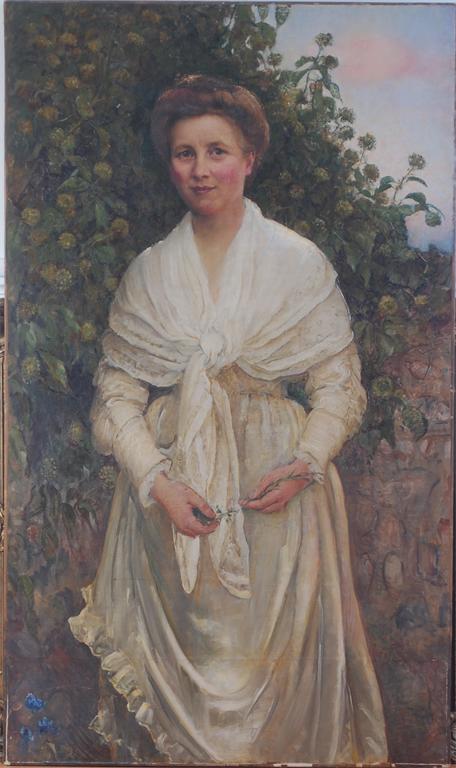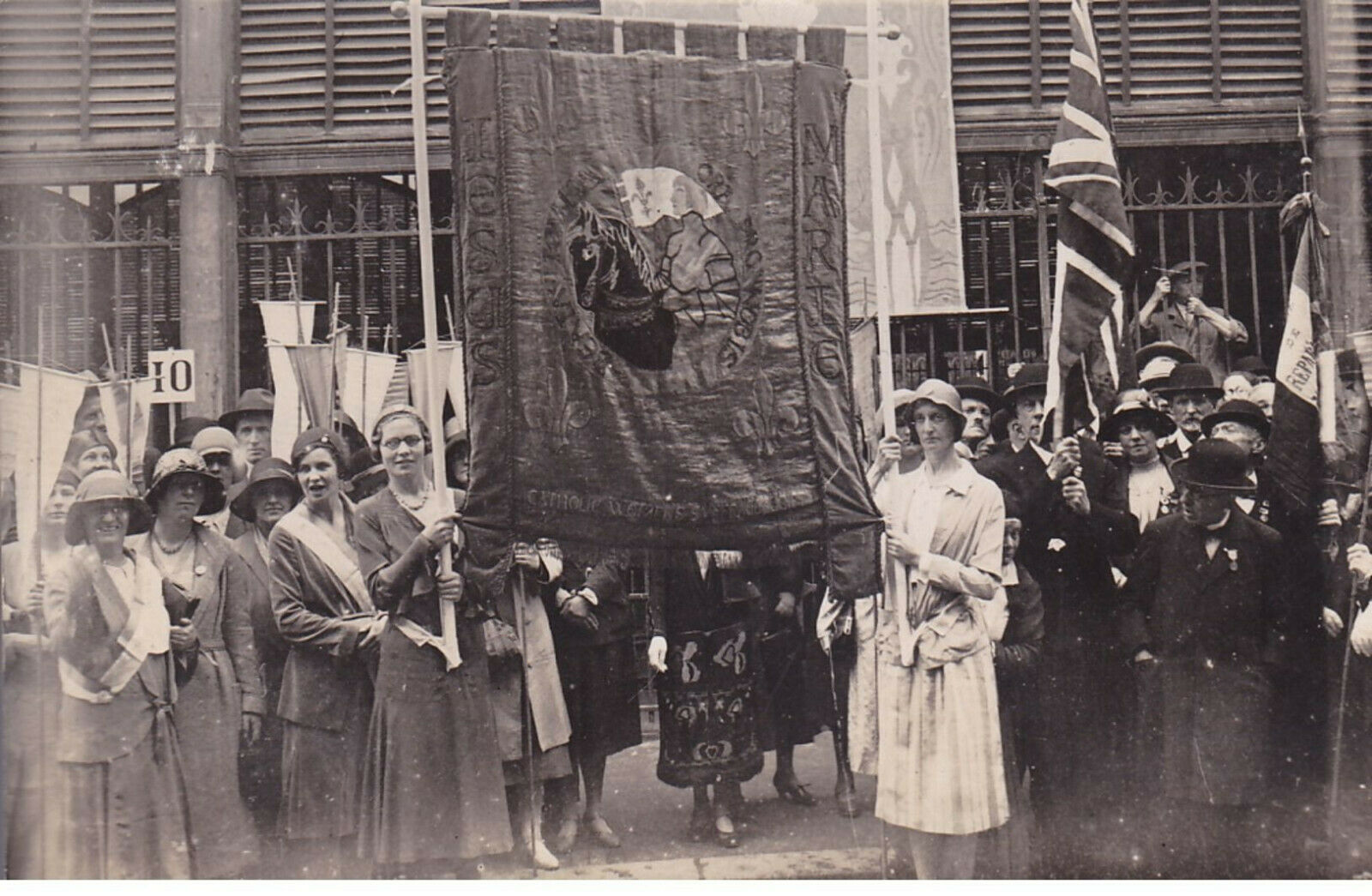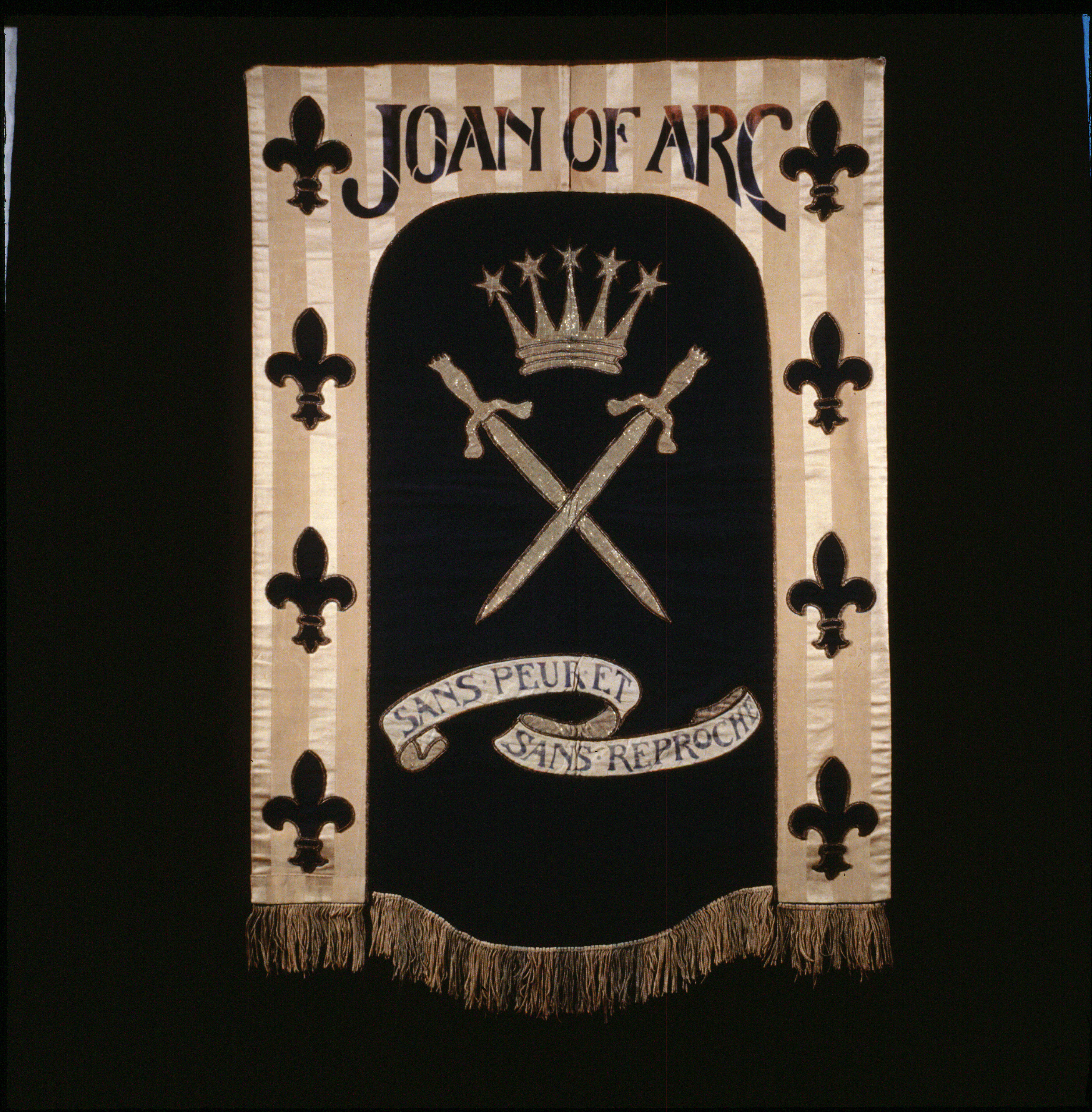Archive for category Art and Suffrage
The Garretts And Their Circle: UPDATED: Even More Annie Swynnerton Revelations
Posted by womanandhersphere in Art and Suffrage, The Garretts and their Circle on March 30, 2023
Excellent News: Millicent Garrett Fawcett has now entered Parliament. A portrait of Millicent Garrett Fawcett by Annie Swynnerton, acquired by The Speaker’s Advisory Committee on Works of Art, was ‘unveiled’ on 27 March 2023. The event, chaired (vivaciously) by Jess Phillips MP, was notable for talks on the sitter and the artist by Prof. Melissa Terras and Dr Emma Merkling.
UPDATE
I wrote a long post earlier this month – revealing the existence of previously unknown collection of Swynnerton portraits, the existence of which enhances our knowledge of the artist. Since then I have tracked down one further associated portrait. Rather than merely issuing a short post with the new information, I thought it best, for completeness, to update the existing post. The ‘new’ portrait is discussed towards the end of this article, the main body of which has been amended where necessary.
Millicent Garrett Fawcett by Annie Swynnerton (Courtesy of The Speaker’s Advisory Committee on Works of Art)
It was in July 2022 that I noticed the portrait had appeared in an art dealer’s listing and immediately alerted Melanie Unwin, who until recently was Deputy Collector of the Palace of Westminster Collection – exclaiming, ‘Now, wouldn’t this be an excellent addition to the Parliamentary Collection?’ And – it has come to pass. Public recognition of Millicent Fawcett is something in which I have taken a personal interest – for ten years ago I posted on this website a plea – ‘Make Millicent Fawcett Visible’. And now, lo – the veil has been lifted – she now has a statue in Westminster Square, her portrait, by Annie Swynnerton, is on show in the Tate,[i] and this other version will now hang in Parliament.
This version, which presumably was painted around the same time (1910) as that bought for the Tate by the Chantrey Bequest in 1930 (the year after Fawcett’s death), remained, for whatever reason, in Annie Swynnerton’s studio and was sold in the February 1934 posthumous sale of her ‘Artistic Effects’. After that it passed through the auction rooms on several occasions but since the early 1970s has remained out of sight. However, thanks to the fact that the National Portrait Gallery archive holds a black-and-white photograph, Melissa Terras and I were able to include this image in Millicent Fawcett: selected writings.[ii]
In Enterprising Women: the Garretts and their circle I hazarded a guess that the Tate’s portrait might have been painted in a first-floor back room at Fawcett’s home, 2 Gower Street, Bloomsbury. However, I’ve now discovered, in a recently-digitised newspaper (the wonder of our age), that ‘Mrs Swynnerton told a Daily Herald representative that half of the portrait was painted in the garden of Dame Millicent’s house in Gower Street and the other half at her own home’.[iii]
Which leads me neatly to the bland, but intriguing, observation that a narrative is shaped by the available information. Thus, in biography, an author takes ‘facts’ about a subject and turns them into a ‘life’. If the ‘facts’ comprise primary sources, such as letters, diaries, newspaper articles, society minutes, oral interviews etc, so much the better – or, at least, easier. But if the subject has left no written trace, information must be wrung from whatever material comes to hand.
And, thus, I leap to the particular. For, in the case of the artist Annie Swynnerton (née Robinson), although there is very little documented information about her early life, serendipity – in the shape of a previously unrecorded collection of family portraits – has recently allowed me to focus the biographical lens on one connection made at the start of her career, that ran as a thread through its entirety, ensured her a place in the canon, and effected the link between the artist and the sitter of Parliament’s latest acquisition.
We know Annie Louisa Robinson was born in Manchester in 1844, the eldest of seven daughters. Her father, Francis Robinson (1814-89), the son of a Yorkshire carpenter,[iv] had risen from what one assumes were relatively humble beginnings, to become a solicitor, with a practice in central Manchester. By the mid-1850s he was sufficiently successful to be able to move his growing family from inner Manchester to a newly-built, detached house in leafy Prestwich Park, 5 km north of the city.[v] In fact Robinson was one of the first house-owners in this development which, guarded by two entrance lodges and with fine views, was intended to appeal to the burgeoning Manchester middle-class.[vi] For some years Robinson involved himself in Manchester affairs; in 1863 he was vice-president of the Manchester Law Association and from at least 1861 was a councillor for St Ann’s Ward and by 1868 its chairman. However, in 1869 disaster struck; he was declared bankrupt. The effect on the family was momentous. In March the entire contents of the home – from a ‘Splendid Walnutwood Drawing-Room Suite, ‘’a sweet-toned cottage pianoforte’, ‘stuffed Australian birds under glass shade’ to a ‘patent coffee percolator’, ‘large brass preserving pans’, and ‘300 choice greenhouse and other plants’ – were all sold at auction.[vii] Stripped from the walls were oil paintings by, among others, Sam Bough, John Brandon Smith, and David Cox, and, from the bookshelves, about 500 volumes, among which were Bryan’s Dictionary of Painters and Engravers.
In June the house itself, with its drawing-room, two dining rooms, breakfast room, library, nine bedrooms, bathrooms, pantries, sculleries, and about half an acre of land, was sold.[viii] The family was then split up. The 1871 census shows Annie (27, Artist), living with her sisters Emily (26, Artist), Julia (24, Artist), Mary (Scholar 16) and Frances (Scholar, 14) in lodgings at 28 Upper Brook Street, back in central Manchester, while Sarah (22) and Adela (19) were visiting with Mrs Sarah Robinson, an elderly widowed relation, and their aunt Mary on the other side of the same street, at number 13.[ix] There is no trace of the Robinson parents in the census but, wherever they were, on census night at least, they were not living with any of their daughters. We must assume that the older sisters now had responsibility for the younger two, who were still at school.
We have no information as to where or how Annie and her sisters were educated. The 1861 Robinson household census does not include a governess, so we can probably conclude that the girls attended a school.[x] Published 30 years later, a brief biographical article in The Queen gives us a rare insight into the Robinson sisters’ early life.[xi]
‘Curiously enough, whilst neither parent had any taste in that direction, Mrs Swynnerton’s two sisters Emily and Julia, were, like herself, born artists, and are both practising their profession in Manchester. When of the tender age of from eleven to thirteen years, Miss Annie used to delight her playfellows, visitors to the house, and the servants with exhibitions of specimens of her very juvenile skill in the shape of water-colour drawings. These primitive works were produced without the advantage of any instruction, and were simply the spontaneous efforts of an inborn, absorbing love of art.’
The Queen commends Francis Robinson for recognising his eldest daughter’s talent and states that ‘she was early placed in the art school at her native city, Manchester’, making no mention of the family’s financial disaster that probably necessitated, or, at least, precipitated, this development. Bankruptcy was unlikely to have struck suddenly and Annie and her sisters may well have been aware of impending disaster. That may be why, from sometime from 1868, Emily, Annie and Julia enrolled as students at the Manchester School of Art. Sensible young women knew a training was necessary if a living was to be earned. Certainly by 1870/1871, with the security they had once enjoyed swept away, the three oldest Robinson sisters were all attending classes at Manchester School of Art.[xii] Here Annie excelled and in 1873 was awarded one of the 10 national gold medals and a Princess of Wales scholarship worth £11 for ‘Group in oils’.[xiii] Julia was presented with a bronze medal and Emily a book prize.[xiv]
In tracing Annie’s developing career I will continue with the known facts and return later to suppositions. Thus, the narrative runs that in 1874 Annie Robinson travelled to Rome with her friend Isabel Dacre to study and paint, returning to Manchester in 1876. We do not know exactly when in 1874 they left Manchester, nor exactly when in 1876 they returned. But we do know that Annie exhibited a painting at the Manchester exhibition in March 1877.[xv]
Mrs Louisa Wilkinson by Annie Swynnerton (credit Kenneth Northover)
Annie was again successful the following March (1878) in having another painting selected to hang in the Manchester exhibition. Most importantly, this was the first of her works to which the name of the subject was attached, a name that was then included in the press reports. [xvi] The painting was a full-length portrait of Mrs Louisa Wilkinson and is the first, dated, evidence of Annie’s lifelong friendship with the Wilkinson family, about which I write in Enterprising Women. When researching and writing that book, I guessed that the Wilkinsons, a leading Manchester family, were likely to have been the conduit through whom Annie entered the Garrett Circle, but until recently I had no material proof of when the connection might first have been made.
Revelation struck in June 2022 on a particularly serendipitous occasion, held to mark the installation, on her one-time Bloomsbury apartment, of an English Heritage Blue Plaque to Fanny Wilkinson (1855-1951), Britain’s first professional woman landscape gardener. It was my research on Fanny, published in Enterprising Women, that directed attention to her work, and I was delighted to listen as a descendant of her youngest sister gave a talk about the Wilkinson family – and was astounded when a portrait of Fanny, by none other than Annie Swynnerton, appeared on the accompanying Powerpoint. During the reception that followed I was thrilled to discover that a South African branch of the family held other portraits of family members painted by Annie, both before and after her marriage. This cache of paintings, previously unknown to the art world, presents us with a key to unlock more information about Annie’s career.
For among these family portraits is the painting of Mrs Louisa Wilkinson (1823-89) that was exhibited in Manchester in 1878. Here she is, fashionably attired in satin, lace, and jewels, her dress, with its swagging, rosettes, ruches, and train, affording Annie every opportunity of displaying a bravura technique. The Wilkinsons were wealthy and philanthropic; there is no doubt that Annie would have been well paid for the portrait. In addition, by permitting her portrait to be exhibited and allowing herself to be named, Mrs Wilkinson was furthering Annie’s cause by advertising her skill. To attract clients from Manchester’s prosperous middle-class an artist had to be able to display their work. Were the Wilkinsons Annie Robinson’s first significant clients?
It may be that Annie received similar portrait commissions at this time but because they were not exhibited by name (or, indeed, have subsequently passed through the auction rooms with no name attached) they are now unknown. The one portrait by Annie that did receive attention in the late 1870s was that of the Rev. W. Gaskell, widower of the novelist Elizabeth Gaskell, which was commissioned by the Portico Library. It was the Rev. Gaskell himself who in 1879 chose to be painted by Annie, remarking ‘My daughters tell me that she has painted a portrait which they like very much.’[xvii] Could it have been the portrait of Mrs Louisa Wilkinson to which they were referring?[xviii]
For the Gaskells and Wilkinsons must surely have known each other. Dr Matthew Eason Wilkinson (1813-78) was Manchester’s leading doctor and his wife, although born in the US, was descended from a radical Manchester family. The Wilkinsons took an interest in art; Fanny, the eldest, put an artistic ‘eye’ and practical ability to good use in forging a novel career, while both Louisa (1859-1936) and Gladys (1864-1957) studied art in London and had works exhibited.
But, to return to the portrait of Mrs Louisa Wilkinson. To have been exhibited in March 1878, this portrait must have been painted sometime earlier, which places Annie firmly in Manchester for at least some of 1877 and, probably, part of 1876. It so happens that the ‘manly, intellectual head’ of Mrs Wilkinson’s husband, Dr Matthew Eason Wilkinson, was, in the autumn of 1877, on display in the studio exhibition of a sculptor, Joseph Swynnerton.[xix] I think, therefore, we can be certain that, whether or not they had known each other previously (and surely they had), the artist and the sculptor must have encountered each other at this time, as they each immortalised Wilkinson père and mère, a pattern repeated the following year when they both produced portraits of the Rev. Gaskell, one in oils and one in marble.
Louisa Wilkinson – second daughter of the Wilkinson family (credit Kenneth Northover)
It was another eleven years before another Annie Swynnerton portrait of a fully-named member of the Wilkinson family was exhibited – and that is this full-length portrait of Louisa Mary Wilkinson, shown at the New Gallery in April/May 1889 . The change of style is remarkable. Louisa was described in the Pall Mall Gazette as ‘a slim figure with an old-fashioned face out of a Dutch picture standing among bluebells and clasping an illuminated missal,[xx] while the Birmingham Daily Post considered it a ‘very original and unconventional portrait, which we found a great deal more human and interesting than the silk and satin gowns with long trains, the feather-fans ad bric-a-brac, with figure-heads attached’.[xxi]
It is now possible to insert a biographical ‘fact’ that may give a slight narrative depth to this picture. For when it was painted, 1888/9, although renting a studio at 6 The Avenue (76 Fulham Road), Annie and Joseph were actually living in Bedford Park, the ‘Queen Anne’, ‘Sweetness and Light’, suburb so popular with artists, their house, 18 St Anne’s Grove, having a purpose-built studio on the top floor.[xxii] At the same time, Mrs Louisa Wilkinson was also a resident of Bedford Park. Although Fanny was living in Bloomsbury, it’s likely that Louisa and her younger sisters lived, at least some of the time, with their mother.[xxiii] I don’t think it too fanciful to suggest that the younger Louisa Wilkinson may have been painted in Bedford Park – standing amongst bluebells (the image I reproduce is, perforce, cropped) either in the garden of Annie’s house or that of her mother.
A few years earlier Louisa had been recorded in the 1881 census as an art student, exhibited that year in the Dudley Gallery and in 1882 at the Walker Gallery, and later turned her hand to book binding. Thus, it’s fitting she’s depicted wearing Artistic Dress, her loose linen garment, with tucks, shoulder embroidery and bodice smocking, cinched by an embroidered belt, hinting at an artist’s smock. She wears no necklace or earrings, the illuminated missal offering sufficient jewelled colours. Perhaps she had bound the missal herself.
In 1894 Annie exhibited the portrait again, including it in a Society of Lady Artists exhibition. Fortunately, the review in The Queen allows us to identify this as the same portrait, by including a description of ‘Portrait of Miss Louisa Wilkinson’: ‘a finely executed picture of a lady facing the spectator, holding, apparently, an illuminated missal in her hands. There is a strong sense of harmony in the scheme of colour, in which a reddish-brown costume plays a not inconspicuous part’. [xxiv] The Manchester Evening News described the portrait as a ‘very “new English” full-length study’.[xxv] Although Annie was not elected a member of the New English Art Club until 1909, she had long been responsive to works by such earlier members as George Clausen.
The two paintings, so different in style – that of Mrs Louisa Wilkinson exhibited in 1878 and her daughter, Louisa, in 1889 – are the only two of Annie’s Wilkinson portraits that were exhibited by name. But they are not the only family portraits by her still held by Wilkinson descendants. As I’m keen to keep supposition separate from known facts, I’m now discussing these separately, rather than inserting them into the known Annie Robinson/Swynnerton chronology.
Jean (on the left) and Gladys Wilkinson (credit Kenneth Northover)
It is possible that the above portrait could have been the first that the Wilkinson family commissioned from Annie. The biographical article published in The Queen mentions that Annie’s ‘.. first picture was a profile picture of a girl’s head, and this she followed with a group, two half-length portraits, called “Gladys and Jean”, which was in the Manchester exhibition.’
Gladys and Jean were the youngest members of the Wilkinson family, born in 1863 and 1876. How old do you think they look in this painting? To me it doesn’t seem possible they could be older than 11 and 7 respectively and that, if so, the double portrait must have been painted no later than 1873/1874, before Annie’s departure abroad.[xxvi] Even in this imperfect photo, we can see that the girls’ satin and lace dresses – and the fashionable Japanese fan held by Gladys – have been lovingly detailed by Annie. It seems plausible that the Wilkinson parents would have commissioned a smaller portrait of their youngest daughters, as a test run, before incurring the expense of a full-length painting of their mother. If The Queen journalist was correctly informed and the painting was indeed exhibited in Manchester, it could have been included in the 1875 Royal Manchester exhibition, the first for which ‘lady exhibitors’, of whom Annie was one, were eligible.[xxvii] Or could it even have been the ‘group in oils’ (which is an echo of the term used of ‘Gladys and Jean’ in The Queen)for which Annie won her Princess of Wales scholarship in 1873? But that is probably too fanciful – and an illustration of how dangerous it is to view a ‘biography’ through a single lens.
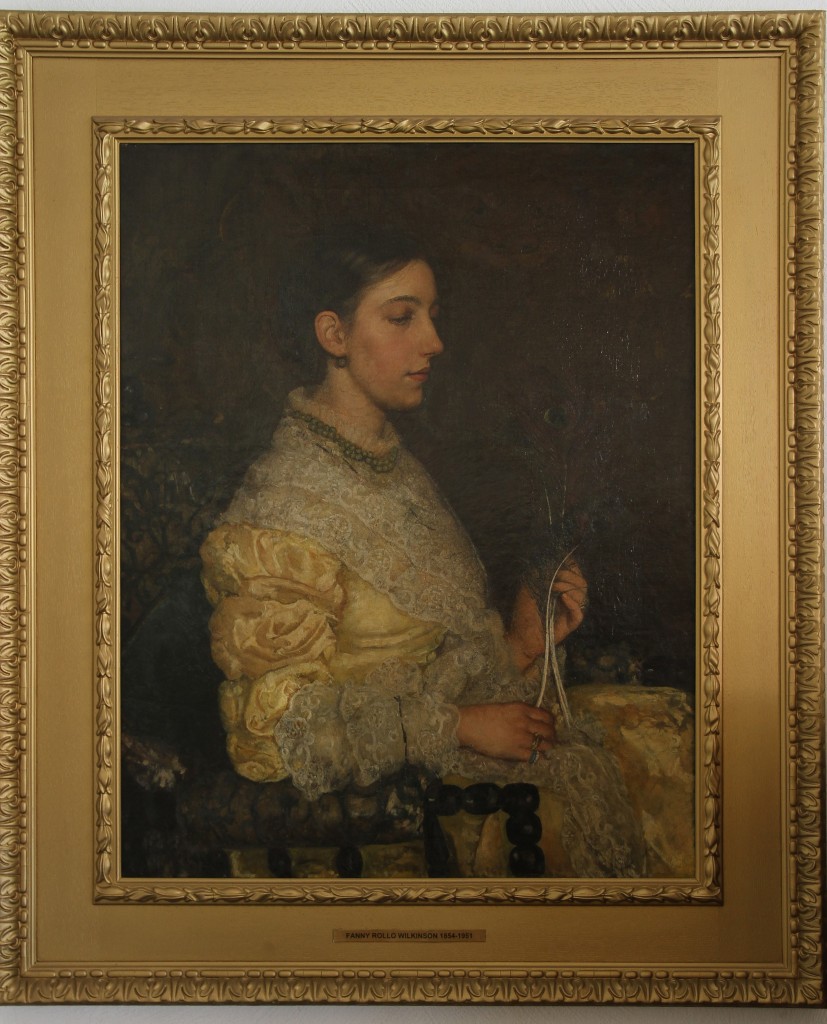
Fanny Wilkinson by Annie Swynnerton (credit Kenneth Northover)
Here, now, is the portrait of a demure Fanny Wilkinson that put me on the trail of the cache of ‘Wilkinson’ paintings. Although it probably does carry a date, that cannot be seen at the moment, and, although it’s possible to gauge the age of young children such as Gladys and Jean, it’s more difficult to do so for a young woman. Although I cannot decide whether it was painted before or after Annie’s stay in Rome (1874-6), I think we can be certain that the portrait was painted before the death of Dr Wilkinson in Autumn 1878 and the family’s consequent move from Manchester to Middlethorpe Hall in Yorkshire.
Fanny is depicted as decidedly ‘Artistic’, the sleeves of her dress bound in a quasi-medieval style, a lace fichu flowing over the bodice, complementing the frothing cuffs. Although we cannot see the whole shape of her dress, it certainly appears more relaxed than her mother’s ruched and flounced costume. The peacock feathers were, of course, the height of Aesthetic accessorizing. The accomplished painting of the yellow satin and the lace once again advertised the artist’s skill. I wonder if the portrait was ever exhibited? I don’t think it can be the ‘profile picture of a girl’s head’ mentioned in the 1890 Queen article – as it’s so much more than ‘a head’.
Louisa Wilkinson by Annie Swynnerton (credit Kenneth Northover)
This is the last of this particular collection of Wilkinson portraits – a sketch of Louisa in a sun bonnet. It is signed ‘A.L. Swynnerton’ and so can be dated to no earlier than 1883 – and her marriage to Joseph – but could perhaps be any time after 1887 (for in that year she was still signing paintings as ‘Robinson’) but before Louisa’s marriage to George Garrett in 1900 (because the title on the frame refers to her as ‘Wilkinson’).[xxviii]
This marriage merely formalised the link between the Garrett and Wilkinson families, the women having already been bound for over two decades in friendship and shared enterprises, with Annie as their preferred portraitist. However, besides the portraits noted above, I knew that Annie Swynnerton had painted another portrait of Louisa Garrett/Wilkinson because I had, very much in passing, seen it when researching Enterprising Women, well over 20 years ago. It was then hanging in a house in Aldeburgh, the home of the widow of a descendant of the wider Garrett family who had inherited ‘Greenheys’ (the Snape home of George and Louisa Garrett). I was there attempting to track down information on the work of Rhoda and Agnes Garret and, although noting the portrait with interest, did not, at the time, record it in any way. But, its existence, if not its form, remained in my memory and in very early 2020, shortly before Covid descended, I set out to try and track it down – and yesterday succeeded.
Louisa Wilkinson (later Mrs George Garrett) by Annie Swynnerton (credit Peter Wood)
The portrait of Louisa Wilkinson is particularly interesting for having Annie Robinson’s monogram prominently displayed in the top left corner. Moreover, I believe it is the painting, catalogued as ‘Louise’, that Swynnerton exhibited at the Walker Gallery, Liverpool, in September 1878. The critic in the Liverpool Mercury (23 September 1878) praised it as ‘A very pleasing and clever picture, unassuming in character of both work and individual; no ostentation, no gilding of nothingness, but a really fine painting. A young and thoughtful face, neat costume, chaste subdued colouring, and good workmanship, make it a work of beauty and promise much to be admired.’
I think, too, that this is ‘Portrait of a Lady’ that Swynnerton exhibited at the Royal Academy in 1879. I make this deduction from an intriguing comment made in the course of an article about Swynnerton that appeared in the 1890 Queen article. In it the writer remarks of her work that ‘An excellent picture, “Louise”, was placed on the line at the RA, this being succeeded by “The Tryst”.’
It is difficult to interpret this remark. Although ‘The Factory Girl’s Tryst’ was shown at the RA in 1881, preceded in 1879 by ‘Portrait of a Lady’ and in 1880 by ‘Portrait of Miss S. Isabel Dacre’, Annie doesn’t appear ever to have exhibited any ‘Louise’ (or ‘Louisa’) at the RA. Unless, of course, the Queen journalist was told that the 1879 ‘Portrait of a Lady’ was that of a particular ‘Louise’ (or ‘Louisa’), in which case it must surely be the portrait exhibited in Liverpool the previous year.
In 1879 The Athenaeum’s reviewer described the RA portrait as of a ‘lady in a grey citron dress, standing against a grey background [which] shows profitable studies of old Italian portraiture with Dutch vraisemblance, and is the first-rate example of the harmonious treatment of low tints and tones in a manner that is not decorative ‘[xxix] What do you think? Could this accord with what you see in the portrait of Louisa Wilkinson? After Liverpool in 1878, was she re-shown at the RA in 1879? As we can see, from the three known portraits, Louisa Wilkinson/Garrett was one of Swynnerton’s favourite subjects. If this was the first, Louisa would have been c 19 in 1878, an age consonant with the sitter of ‘Louise’, Knowing that Swynnerton had also recently painted her mother and three of her sisters, it seems entirely credible that this portrait of Louisa would have been painted in 1878 and, hence, that it is the portrait exhibited at the Walker Gallery and the Royal Academy.
I also know that, over the years, Swynnerton painted Louisa Garrett Anderson (daughter of Elizabeth Garrett Anderson and niece of Millicent Fawcett) and Rhoda Garrett (cousin and partner of Agnes Garrett), although their whereabouts is not now known. However, in the course of researching this article I think I have made one discovery.
Agnes Garrett by Annie Swynnerton (courtesy of Lacy Scott and Knight)
For, on Jonathan Russell’s excellent website, under details of the paintings shown at the 1923 exhibition of Annie’s works, I came across this – described as ‘Portrait of a lady standing by flowering ivy’. It was sold, unframed, at auction twice, in quick succession, in 2014.[xxx] I am certain that this is the portrait that Annie painted of Agnes Garrett – at Agnes’ holiday home in Rustington, in the summer of 1885. The subject not only looks like Agnes, but I can see Sussex knapped flints in the wall behind her. This painting was included in the 1923 Manchester exhibition of Annie’s works – and I know that Agnes’ portrait was also there, in Room 7, lent by her sister-in-law, Louisa Garrett. This must surely be it.
In Enterprising Women I describe in detail how the Wilkinsons, the Garretts, and other members of their circle did so much – through their ‘matronage’ – to ensure Annie Swynnerton’s presence on art gallery walls. And she, in turn, has ensured that her friends and associates, as they hang on the walls of family homes, are still known to their descendants.
You can find other posts about Annie Swynnerton on this website by putting ‘The Garretts and their Circle’ into the Searchbox.
For International Women’s Day 2023 the Pre-Raphaelite Society invited me to talk about Annie Swynnerton. You can find the resulting 2 podcasts here.
[i] When, c. 2000, I was researching Enterprising Women:the Garretts and their circle (Francis Boutle, 2002) the I had to visit the Tate storage facility in order to view the Swynnerton portrait of Millicent Fawcett. It was subsequently shown in Wales, at Bodelwydden Castle, but returned to London for the suffrage centenary in 2018.
[ii] M. Terras and E. Crawford (eds), Millicent Garrett Fawcett: selected writings, UCL Press. Free to download https://discovery.ucl.ac.uk/id/eprint/10149793/1/Millicent-Garret-Fawcett.pdf p 315.
[iii] Daily Herald, 7 May 1930, 1. Swynnerton’s home and studio in 1910 was 1a The Avenue, 76 Fulham Road, London W.
[iv] Information from Francis Robinson’s Articles of Clerkship, 1836 via Ancestry.
[v] I note that the two youngest Robinson daughters were both born in Prestwich. The elder, Mary, was baptised at St Mary’s, Prestwich, on 3 March 1856.
[vi] For something on the history of Prestwich Park see https://www.bury.gov.uk/CHttpHandler.ashx?id=5382&p=0. In the advertisement for the sale of the Robinsons’ household goods in the Manchester Courier, 6 March 1869, the house was described as ‘the second house from the Bottom Lodge, Prestwich Park.
[vii] Manchester Courier,6 March 1869.
[viii] Manchester Courier, 5 June 1869.
[ix] C. Allen and P. Morris, Annie Swynnerton: painter and pioneer, Sarsen Press, 2018, identifies the widowed relation as Francis Robinson’s stepmother
[x] In 1861 Miss Hannah Dickinson’s Ladies’ College opened at Hill-side House, in Prestwich Park, close to the Robinsons’ home. Although Annie would have been then too old, it’s unlikely that even her younger sisters were pupils, as Its fees, even for day girls, were high, 16-20 guineas per annum. Miss Dickinson stressed that she had chosen Prestwich Park for its ‘beautiful scenery, its rural glens, its retired walks, and salubrious breezes – as well as ‘its kind-hearted inhabitants’. Miss Dickinson, Thoughts on Woman and Her Education, Longman Green, 1861, p2
[xi] The Queen, 15 March 1890.
[xii] No firm, primary, evidence has come to light as to when exactly the sisters – either individually or together – enrolled at the School of Art. However, Allen and Morris (p. 19) have established very persuasively that Emily ‘was certainly there from at least autumn 1868’ and that Annie, too, had probably been enrolled in 1868, and Julia certainly by 1869-70.
[xiii] Manchester Evening News, 20 August 1873.
[xiv] Manchester Courier, 13 July 1874.
[xv] It was only in 1875 that 9 ‘Lady exhibitors’ were elected for the first time – among whom were Annie Robinson and Isabel Dacre.
[xvi] ‘Miss Annie L. Robinson has a large full-length portrait of Mrs. Eason Wilkinson … and although defective in some respects, gives promise of better work in the future.’ (The Manchester Courier, and Lancashire General Advertiser, 8 March 1878.)
[xvii] Rev. Gaskell quoted in B. Brill, William Gaskell, 1805-84: a portrait, Manchester Literary and Philosophical Publications, 110-11.
[xviii] The portrait of the Rev. Gaskell now hangs in the Gaskells’ former home – see https://elizabethgaskellhouse.co.uk/
[xix] Manchester Times, 6 October 1877. Dr Wilkinson was that year president of the British Medical Association, whose meeting had been held that summer in Manchester. The portrait bust may have been intended to mark this achievement. I have no knowledge of what has become of it. Swynnerton’s studio was at 35 Barton Arcade. In 1880 the address of the Manchester Society for Women Painters was 10 Barton House, Deansgate, which must have been close to the Arcade.
[xx] Pall Mall Gazette, 1 May 1889. At this time both artist and sitter had moved from Manchester; Annie had a London base at the Avenue Studios, 76 Fulham Road, W. and Louisa Wilkinson was living, with her sister Fanny, at 15 Bloomsbury St, WC.
[xxi] Birmingham Daily Post, 18 May 1889.
[xxii] Annie gave th e St Anne’s Grove address when she submitted work in 1888 to the Society of Women Artists and the Swynnertons were still living there in 1891. However, it is only Annie’s name – and that of her Aunt Mary and their one servant – that appears on the census because the previous page, which must include Joseph as the last entry, is missing – or has been missed when scanning. The page reference that shows Annie’s presence at 18 Queen Anne’s Grove is RG12/1038 folio 8 page 33 schedule 193. Information on the Swynnertons’ occupation of these addresses can be found in the London Electoral Register via Ancestry.
[xxiii] Mrs Wilkinson was living in Bedford Park from at least 1886 and died there in 1889. Her house is only referred to as ‘The Chestnuts’ and I have been unable to discover the exact address.
[xxiv] The Queen, 28 April 1894.
[xxv] Manchester Evening News, 21 April 1894.
[xxvi] The double portrait of ‘Gladys and Jean’ may be dated, but at the moment that information is not accessible.
[xxvii] Alas, I have not yet been able to consult the catalogue for this exhibition. If anyone does know if a portrait by Miss Robinson of two young girls was included do, please, let me know.
[xxviii] For information about the change of signature see https://annielouisaswynnerton.com/ordered-by-date/ .
[xxix] Thanks to Julie Foster for pinpointing the Liverpool Mercury reference. The Atheneum, 5th and concluding notice of RA Summer Exhibition, 7 June 1879,734.
[xxx] . Unfortunately, neither of the East Anglian auction houses who sold the painting holds records as far back as 2014 and I’ve been unable to discover any more information about the painting, or its current whereabouts.
ANNIE SWYNNERTON: My Podcast for the Pre-Raphaelite Society
Posted by womanandhersphere in Art and Suffrage, The Garretts and their Circle on March 8, 2023
Lock-Down Research: The Case Of The Mysterious Suffrage Banner
Posted by womanandhersphere in Art and Suffrage, Lock-Down Research on June 29, 2020
I find it so satisfying when I am able to bring a photograph such as this to life. I acquired it two years ago but have not yet catalogued it because I could identify neither the banner nor the occasion. However, a little tenacity, a few idle lock-down hours and – EUREKA – I have found the answer.
The card came, with many others, in the collection of suffrage postcards compiled by the Hodgson Sisters . From this context I assumed the card had a suffrage connection, but I had never seen or heard of the banner. The photographer, as you will see from the imprint, was A. Dron of Brondesbury – so, as the Hodgsons were living in West Hampstead, I assumed the occasion pictured occurred in the area.
Even with a magnifying glass I couldn’t make out much more detail and it was only when I scanned the card and blew up the image that I found at the bottom right of the banner what seemed to be the artist’s monogram and a date – W E G S 1910. I felt I was making progress, but I’d never come across those initials when compiling my Art and Suffrage: a biographical dictionary of suffrage artists – and so was not much further forward.
I had tried searching for variations of ‘The Old Order Changeth’ in the British Newspaper Archive, but nothing relating to a banner had emerged. It was only when I searched for ‘banner’ in what I thought might be the local paper for Brondesbury in 1910, that the answer emerged. And it all seems so easy now.
The newspaper report in the Kilburn Times, 17 June 1910, revealed that the banner, a present to the North West London Union of the Women’s Social and Political Union, had been unfurled by Mrs Saul Solomon and was to be carried in the WSPU ‘Prison to Citizenship’ procession on Saturday 18 June. The artist was William Ewart Glasdstone Solomon [WEGS] (1880-1965), Mrs Solomon’s son.
Mrs Georgiana Solomon (1844-1933) was the widow of the governor-general of Cape Colony and had for many years been active in social reform and suffrage movements. By 1910 she was living in West Hampstead and had already been arrested once. Five months after the photograph was taken she was assaulted in the course of the notorious ‘Black Friday’ debacle in Parliament Square and in March 1912 was imprisoned after taking part in the WSPU window-smashing campaign. Her daughter, Daisy, who was also an active WSPU member, featured in one of their publicity stunts, sent in 1909 as a ‘human letter to 10 Downing Street. She also served a prison term and by 1912 was organizing secretary of the Hampstead branch of the WSPU.
Given the family association, it is not surprising that Mrs Solomon’s son, who had been a student at the Royal Academy Schools, should have put his art to the service of the Cause. He later became director of the Sir J.J. School of Art in Bombay (Mumbai) before eventually returning to South Africa, the land of his birth. He is classed as a ‘South African artist’ but we can now appreciate that one of his earlier works was in support of the British women’s suffrage movement.
The newspaper article includes the information that the banner depicts ‘two life-size figures, a man and a woman, and the idea which the artist apparently means to convey is the dawn of a new era of political sex equality. The lettering ‘Political equality’ and ‘The old order changeth, giving place to new’ is conspicuous on the canvas’. I haven’t been able to spot the words ‘Political equality’, but perhaps they are on the reverse.
The Kilburn Times report tells us that the unfurling of the ‘Old Order Changeth’ banner took place at ‘Plympton House’, 154 Willesden Lane, which was the home of Mr and Mrs A.A. Jones, and that speeches were made by Helen Ogston and Flora Drummond. Mrs Eleanor Penn Gaskell was also present. Alas, I cannot identify the two young women holding the banner. Possible candidates that spring to mind are Daisy Solomon and Helen Ogston, but neither look quite like the women in the photograph. Nor are they, I think, any of the Hodgson Sisters.
I now see that the report for the WSPU N.W. London branch carried in the issue of Votes for Women for17 June 1910 declares ‘Let no local women miss the chance of walking in the great Procession under Mr W. E. Gladstone Solomon’s most beautiful banner’.
And there I rest my case…so pleased to have retrieved the story behind this most intriguing of photographs.
Copyright


